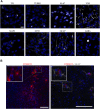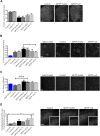Multifactoriality of Parkinson's Disease as Explored Through Human Neural Stem Cells and Their Transplantation in Middle-Aged Parkinsonian Mice
- PMID: 35126116
- PMCID: PMC8807563
- DOI: 10.3389/fphar.2021.773925
Multifactoriality of Parkinson's Disease as Explored Through Human Neural Stem Cells and Their Transplantation in Middle-Aged Parkinsonian Mice
Abstract
Parkinson's disease (PD) is an age-associated neurodegenerative disorder for which there is currently no cure. Cell replacement therapy is a potential treatment for PD; however, this therapy has more clinically beneficial outcomes in younger patients with less advanced PD. In this study, hVM1 clone 32 cells, a line of human neural stem cells, were characterized and subsequently transplanted in middle-aged Parkinsonian mice in order to examine cell replacement therapy as a treatment for PD. In vitro analyses revealed that these cells express standard dopamine-centered markers as well as others associated with mitochondrial and peroxisome function, as well as glucose and lipid metabolism. Four months after the transplantation of the hVM1 clone 32 cells, striatal expression of tyrosine hydroxylase was minimally reduced in all Parkinsonian mice but that of dopamine transporter was decreased to a greater extent in buffer compared to cell-treated mice. Behavioral tests showed marked differences between experimental groups, and cell transplant improved hyperactivity and gait alterations, while in the striatum, astroglial populations were increased in all groups due to age and a higher amount of microglia were found in Parkinsonian mice. In the motor cortex, nonphosphorylated neurofilament heavy was increased in all Parkinsonian mice. Overall, these findings demonstrate that hVM1 clone 32 cell transplant prevented motor and non-motor impairments and that PD is a complex disorder with many influencing factors, thus reinforcing the idea of novel targets for PD treatment that tend to be focused on dopamine and nigrostriatal damage.
Keywords: aging; behavior; cell replacement therapy; neural stem cell; neuroinflammation; next-generation sequencing; parkinson’s disease; proteomics.
Copyright © 2022 Nelke, García-López, Martínez-Serrano and Pereira.
Conflict of interest statement
The authors declare that the research was conducted in the absence of any commercial or financial relationships that could be construed as a potential conflict of interest.
Figures






Similar articles
-
The therapeutic use of clonal neural stem cells in experimental Parkinson´s disease.Stem Cell Res Ther. 2024 Oct 9;15(1):356. doi: 10.1186/s13287-024-03965-0. Stem Cell Res Ther. 2024. PMID: 39385216 Free PMC article.
-
Long term behavioral effects of functional dopaminergic neurons generated from human neural stem cells in the rat 6-OH-DA Parkinson's disease model. Effects of the forced expression of BCL-X(L).Behav Brain Res. 2012 Jun 15;232(1):225-32. doi: 10.1016/j.bbr.2012.04.020. Epub 2012 Apr 17. Behav Brain Res. 2012. PMID: 22537773
-
Succinobucol, a Non-Statin Hypocholesterolemic Drug, Prevents Premotor Symptoms and Nigrostriatal Neurodegeneration in an Experimental Model of Parkinson's Disease.Mol Neurobiol. 2017 Mar;54(2):1513-1530. doi: 10.1007/s12035-016-9747-z. Epub 2016 Feb 6. Mol Neurobiol. 2017. PMID: 26852411
-
Potential application of induced pluripotent stem cells in cell replacement therapy for Parkinson's disease.CNS Neurol Disord Drug Targets. 2011 Jun;10(4):449-58. doi: 10.2174/187152711795563994. CNS Neurol Disord Drug Targets. 2011. PMID: 21495962 Review.
-
Cell transplantation in the damaged adult brain.Rev Neurol (Paris). 2013 Nov;169(11):838-43. doi: 10.1016/j.neurol.2013.07.026. Epub 2013 Oct 7. Rev Neurol (Paris). 2013. PMID: 24112517 Review.
Cited by
-
Neural stem cells for Parkinson's disease management: Challenges, nanobased support, and prospects.World J Stem Cells. 2023 Jul 26;15(7):687-700. doi: 10.4252/wjsc.v15.i7.687. World J Stem Cells. 2023. PMID: 37545757 Free PMC article. Review.
-
Therapeutic role of neural stem cells in neurological diseases.Front Bioeng Biotechnol. 2024 Mar 7;12:1329712. doi: 10.3389/fbioe.2024.1329712. eCollection 2024. Front Bioeng Biotechnol. 2024. PMID: 38515621 Free PMC article. Review.
-
The therapeutic use of clonal neural stem cells in experimental Parkinson´s disease.Stem Cell Res Ther. 2024 Oct 9;15(1):356. doi: 10.1186/s13287-024-03965-0. Stem Cell Res Ther. 2024. PMID: 39385216 Free PMC article.
-
Cell-based regenerative and rejuvenation strategies for treating neurodegenerative diseases.Stem Cell Res Ther. 2025 Apr 6;16(1):167. doi: 10.1186/s13287-025-04285-7. Stem Cell Res Ther. 2025. PMID: 40189500 Free PMC article. Review.
-
Application and prospects of high-throughput screening for in vitro neurogenesis.World J Stem Cells. 2022 Jun 26;14(6):393-419. doi: 10.4252/wjsc.v14.i6.393. World J Stem Cells. 2022. PMID: 35949394 Free PMC article. Review.
References
LinkOut - more resources
Full Text Sources

